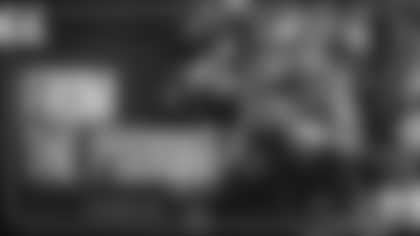LOS ANGELES – The Olympic Games are underway, and there's one sport that could offer concept carryover to the NFL's new hybrid kickoff format: Rugby.
"I have not watched anything yet," Rams special teams coordinator Chase Blackburn said. "I have not watched the rugby, but it's going to be something similar."
As Blackburn and other special teams coaches across NFL training camps experiment with different approaches to the hybrid kickoff format debuting in the 2024 season, they are learning how far their creativity can go.
The league reportedly sent a memo to all 32 teams saying that the ball must be placed upright, rather than sideways, on the kicking tee. In other words, cross that off as a way of throwing off the return unit under the new setup.
According to Blackburn, it's possible to get "a lot of different types of balls" when the ball is laid differently on the tee. He said when it's in the well of the tee straight up and down, there's less variance with the kick one will get. Leaning the ball up against the tee is still allowed, but if it's on the tee, it must be in it.
"It's been really good," Blackburn said of troubleshooting the format. "There's a lot of... obviously, on the other field, we're working a lot of individual with the punters, the specialists, (and) the snapper, holds, all of that kind of stuff, (the) mechanics. Obviously, our kickers (are) getting a lot of work over there, plus what you see over here in the team periods. As far as just the mechanics of the kickoff return, (the NFL) sent the memo out about having the ball in the tee and certain things there. Some things have changed from the offseason. We'll be ready for any other adjustments as they come, but we're kind of staying the course. We have some good kickoff return reps today, individual-type work tomorrow. We'll get some schematics and kind of put it all together."
The new kickoff format is modeled after the XFL's, but not an exact replica. As a refresher:
- The kicker will still kick off from his 35-yard line, but the other 10 members of the kicking team will be lining up at the receiving team's 40-yard line. The play can't start until 10 members have at least one foot on the 40; five of those players must be on each side of the ball, which prevents the kicking team from loading up one side.
- After kicking the ball, the kicker won't be able to cross midfield until the ball is in play – defined as the returning catching it, or the ball hitting the ground in the landing zone, or the ball getting to the endzone.
- Meanwhile, the receiving team will have a 5-yard setup zone from its own 30 to its 35-yard line. Seven of the receiving team's players must have their foot on the 35-yard line. Players not on the 35 must be lined up in the setup zone outside the hash marks, and all players in the setup zone can't move until the kick has hit the ground or a player in the landing zone or the endzone.
- No more than two returners may line up in the landing zone and and can move at any time before or during the kick.
- Landing zone is defined as the area between the receiving team's goal line and its 20-yard line.
- A kick that lands short of the landing zone is treated like a kickoff out of bounds, with the ball being spotted at the receiving team's 40-yard line.
- A kick that hits in the landing zone must be returned.
- A kick that hits the landing zone and then goes into the endzone must be returned or downed by the receiving team. If downed, it's a touchback to the receiving team's 20-yard line.
- A kick that hits in the endzone and stays inbounds (returned or downed) – touchback to the receiving team's 30-yard line if downed
- A kick that goes out of the back of the endzone (in the air or bounces) – touchback to the receiving team's 30-yard line.
- No fair catch or signal is allowed.
One key difference from the XFL is that under the NFL's format, kickoff team and return team are further from the returner and creating more ground to cover. Still, XFL film is the closest thing NFL teams have as a resource for studying the format and brainstorming concepts.
"(I) continue to watch the XFL stuff over and over again, continue to watch offensive plays, things that may take place in certain situations and continue to evaluate all," Blackburn said. "We were able to do a lot in phase three where we threw a lot of team on kickoff vs kickoff return, a lot of variations of kickoffs, a lot of variations of coverages, a lot of variations of kickoff return schemes, a lot of body types. So (I'm) really studying that, what worked, what didn't, (and) really fine-tuning some of our verbiage on both phases, kickoff (and) kickoff return and how we want to attack it and what our philosophy is. So really kind of dialing that in."
The collaboration with the offensive staff that took place during OTAs this spring has continued in training camp as Blackburn and assistant special teams coach Chili Davis work concepts for that phase. Soon, they will be able to put them to the test with the first of four joint practices coming up on Sunday (Chargers in El Segundo). However, it remains to be seen how much of those plans the Rams will truly show, as well as other teams.
Blackburn called the joint practices "an accelerated opportunity" for refining kickoffs and returns.
"Who knows how vanilla or exotic people will get in the preseason," Blackburn said. "Some people don't want to show things, some people will try things. What type of schemes, what type of personnel (or) what type of kicks? All those things are up in the air. Everyone might have a different philosophy or a different belief in what works. You'll probably see in a couple weeks things will manipulate and change because someone has success here or doesn't have success with that. You evolve, you adapt and overcome. That's what we are as coaches. You have to be able to adapt."














